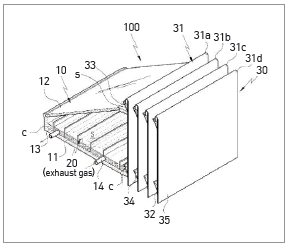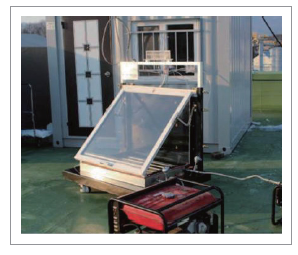Seawater desalination apparatus that uses solar energy and various
waste heat to desalinate seawater and increases the solar energy
collecting effect using multiple reflectors
Client / Market
- Areas with water shortage in islands, the Middle East, South-East Asia, Africa,
- KOICA project-linked business, solar salt manufacturer, seawater concentration recycling business

Necessity of this Technology
- Reverse osmosis method, the general method for seawater desalination, requires large electric power consumption and has difficulty in maintenance and repair.
- Among distillation methods, large capacity multiple-effect distillation requires expensive initial establishment cost and maintenance fee as well as complex maintenance technology, which is not appropriate to be applied in areas having difficulty with energy supply like island areas and underdeveloped areas.
- Existing seawater desalination equipment using solar heat takes the solar still type or uses commercial solar thermal collector and heat exchanger, which accompanies indirect heat collection and heat exchange, resulting in low performance and efficiency.
- Therefore, it calls for an eco-friendly seawater desalination apparatus that does not require a lot of energy yet has better fresh water generating ability than existing desalination method using solar heat.
Technical Differentiation
- This invention can desalinate sweater using solar heat and various waste heat that it can generate fresh water when solar radiation condition is poor.
- Solar energy going through the multiple-effect distiller and the condensation heat in the basin part are combined to be used as the source of evaporation heat in the multiple-effect distiller. Latent heat condensed in the multiple-effect distiller is reused as the heat source in the next effects so that fresh water production and heat efficiency are improved.
- Therefore, compared to existing seawater desalination using commercial solar thermal collector, it can increase the fresh water production by 50 to 430% from the same area. The design does not require decompression so that maintenance is easy.
- It can be used as an eco-friendly small capacity desalination facility in islands, coastal areas, and remote areas that lack electrical or water supply facilities due to regional/ economic conditions or a distributed small-scale desalination facility in regions with economic feasibility considering the water transfer cost and high oil prices.
- This hybrid solar desalination apparatus can use solar heat and waste heat
independently or simultaneously as the source of evaporation heat, and it integrated the fresh water production ability of solar still with verified durability and the multiple-effect technology that can boost the efficiency.
- Therefore, the fresh water production ability was maximized and the maintainability is high to be utilized in underdeveloped areas with poor technical/economic conditions.
- The installation cost is low as it does not require heat exchanger, commercial solar thermal collector, and heat storage tank but the performance of the apparatus is 18 L/m²·d , which is a world-class level.

Excellence of Technology
- This invention can desalinate sweater using solar heat and various waste heat that it can generate fresh water when solar radiation condition is poor.
- Solar energy going through the multiple-effect distiller and the condensation heat in the basin part are combined to be used as the source of evaporation heat in the
multiple-effect distiller. Latent heat condensed in the multiple-effect distiller is reused as the heat source in the next effects so that fresh water production and heat efficiency are improved.
Therefore, compared to existing seawater desalination using commercial solar thermal collector, it can increase the fresh water production by 50 to 430% from the same area. The design does not require decompression so that maintenance is easy.
- It can be used as an eco-friendly small capacity desalination facility in islands, coastal areas, and remote areas that lack electrical or water supply facilities due to regional / economic conditions or a distributed small-scale desalination facility in regions with neconomic feasibility considering the water transfer cost and high oil prices.
- This hybrid solar desalination apparatus can use solar heat and waste heat
independently or simultaneously as the source of evaporation heat, and it integrated the fresh water production ability of solar still with verified durability and the multiple-effect technology that can boost the efficiency.
- Therefore, the fresh water production ability was maximized and the maintainability is high to be utilized in underdeveloped areas with poor technical/economic conditions.
- The installation cost is low as it does not require heat exchanger, commercial solar thermal collector, and heat storage tank but the performance of the apparatus is 18 L/m²·d , which is a world-class level.
Current Intellectual Property Right Status
PATENT
- Multiple-effect Atmospheric Pressure Desalination Apparatus Using Solar Heat and Multiple Source of Heat (US14/408376) and 18 registered patents, 11 patent applications
KNOW-HOW
- Design/production technology for seawater desalination using solar heat
- Performance estimation technology for seawater desalination using solar heat

|






